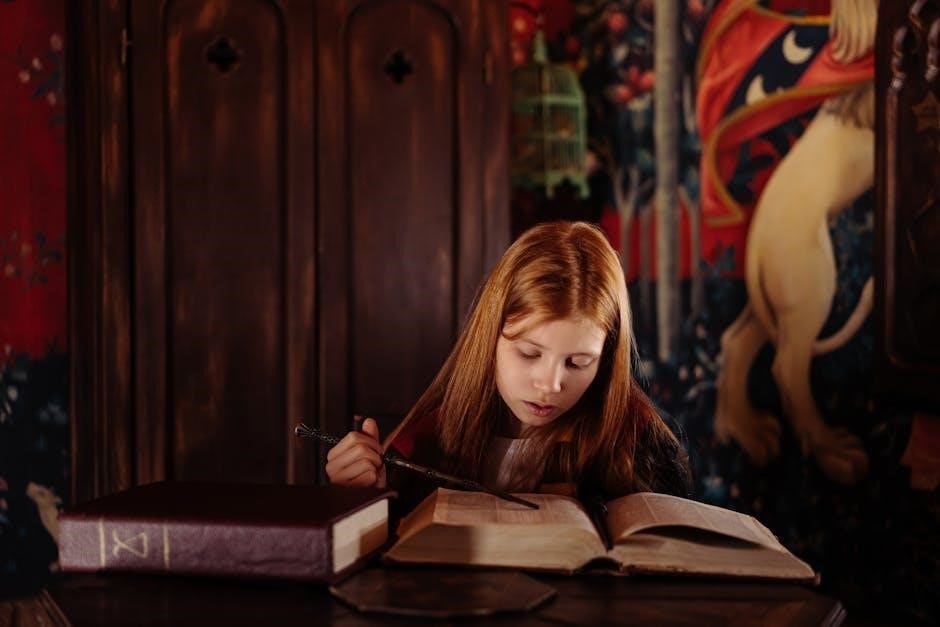The General Prologue to The Canterbury Tales is a foundational element, introducing a diverse group of pilgrims. It sets the stage for their journey and stories.
1.1 Overview of The Canterbury Tales
Geoffrey Chaucer’s The Canterbury Tales is a seminal work of Middle English literature, written in the late 14th century. It follows a diverse group of pilgrims traveling to Canterbury Cathedral, each representing different social classes and professions. The narrative is framed by a General Prologue, introducing these characters, and features a collection of tales told during their journey. Chaucer’s masterpiece blends humor, satire, and moral reflection, showcasing his literary genius and insight into human nature.
1.2 The Role of the General Prologue in the Narrative
The General Prologue serves as the narrative cornerstone of The Canterbury Tales, setting the stage for the entire work. It introduces the pilgrims, establishing their backgrounds, personalities, and social roles. This section provides context for their journey and the tales they will tell, while also highlighting Chaucer’s satirical and observational style. The Prologue not only unites the diverse characters but also sets the thematic tone for the stories that follow.
1.3 Historical Context of the Work
The General Prologue was written in the late 14th century, a period marked by social change and the rise of the middle class. The Black Death had reshaped England’s economy and society, influencing Chaucer’s portrayal of characters from various classes. The Hundred Years’ War and religious movements also impacted the narrative, reflecting the political and cultural shifts of the time. This context enriches the Prologue’s themes and characterizations.
Structure and Style of the General Prologue
The General Prologue features a structured narrative with rhyming couplets and a consistent meter, showcasing Chaucer’s mastery of Middle English and literary devices like imagery and satire.
2.1 Literary Devices Used by Chaucer
Chaucer employs vivid imagery, satire, and symbolism in the General Prologue. His use of satire critiques the Church and societal norms, while imagery, like the “sweet showers of April,” evokes spring’s renewal. Symbolism, such as the pilgrims’ attire and actions, reflects their moral and social standing, enriching the narrative with layered meanings and depth, making the Prologue a masterful blend of literary artistry and social commentary.
2.2 The Use of Rhyming Couplets and Meter
Chaucer’s General Prologue features a consistent use of rhyming couplets and a decasyllabic meter, creating a rhythmic flow that enhances the narrative. The poem follows a pattern of end rhyme, with each pair of lines rhyming, which adds musicality and structure. This meter, common in Middle English poetry, aids in the storytelling and character portrayals, making the Prologue both engaging and memorable, while also reflecting the era’s poetic traditions.
2.3 The Opening Lines and Their Significance
The opening lines of the General Prologue, beginning with “WHAN that Aprille with his shoures soote,” vividly depict spring’s renewal, setting a poetic tone. These lines introduce the pilgrimage’s backdrop, emphasizing nature’s cycles and human unity. Chaucer’s use of imagery and symbolism here establishes themes of rebirth and communal journey, drawing readers into the narrative while reflecting the cultural and spiritual context of the medieval period.

Characters Introduced in the General Prologue

The General Prologue introduces a diverse cast of pilgrims, representing various social classes, professions, and moral standings, each uniquely portrayed to reflect medieval society’s complexity and vibrancy.
3.1 The Pilgrims and Their Social Classes
The General Prologue meticulously portrays pilgrims from varied social strata, such as knights, monks, merchants, and peasants, reflecting the hierarchical structure of medieval society. Each character’s depiction highlights their profession, mannerisms, and moral fiber, offering a vivid snapshot of 14th-century England’s diverse population and their distinct roles within the social framework of the time.
3.2 The Knight and His Representation of Chivalry
The Knight, as depicted in the General Prologue, embodies the ideals of chivalry, showcasing honor, bravery, and humility. His participation in numerous battles and pilgrimages underscores his noble character and adherence to the chivalric code, making him a symbol of moral integrity and a paradigm of the ideal medieval knight.
3.3 The Wife of Bath and Her Symbolism

The Wife of Bath is a vibrant, complex character in the General Prologue, symbolizing female agency and challenge to patriarchal norms. Her elaborate dress and numerous marriages reflect her confidence and desire for autonomy. She embodies the contradictions of medieval gender roles, using her wit and experience to assert her voice, making her a powerful and enduring figure in literature.

Themes and Symbolism in the Prologue
The General Prologue explores themes of satire, social hierarchy, and moral critique. It symbolizes the diversity of medieval society through its vivid character portrayals and their roles.
4.1 The Celebration of Spring and Renewal
The General Prologue opens with a vivid celebration of spring, depicting April showers reviving the earth after winter. This imagery symbolizes renewal and fresh beginnings, mirroring the pilgrims’ spiritual journey. The vibrant descriptions of nature underscore themes of rebirth and hope, setting a lively tone for the tales ahead. The cyclical nature of life is highlighted, reflecting medieval beliefs in seasonal renewal and divine order.

4.2 The Satirical Portrayal of the Church

Chaucer’s General Prologue critiques the Church through satirical depictions of clergy. Characters like the Monk and Friar embody corruption, exploiting their roles for personal gain. The Pardoner, selling fake relics, highlights greed. The Wife of Bath’s challenges to religious norms further illustrate Chaucer’s disdain for hypocrisy. These portrayals reflect widespread dissatisfaction with the Church’s practices and misuse of power during the Middle Ages, offering sharp social commentary.
4.3 The Reflection of Medieval Society
The General Prologue vividly reflects medieval society by portraying pilgrims from diverse social classes. Chaucer’s characters, such as the Knight, Wife of Bath, and Pardoner, represent various professions and lifestyles. Their interactions and traits mirror the social hierarchy and cultural norms of the time, offering a comprehensive view of 14th-century England. This portrayal highlights the complexities and vibrancy of medieval life, capturing its moral, economic, and religious dimensions with remarkable detail.
Language and Translation Challenges
The General Prologue is written in Middle English, posing challenges for modern readers. Its archaic language and complex structure require careful translation to preserve Chaucer’s original intent.
5.1 Middle English and Its Challenges for Modern Readers
The General Prologue, written in Middle English, presents challenges for modern readers due to its archaic language and spelling variations. The text’s unfamiliar vocabulary, complex grammar, and lack of standardization require careful study. Additionally, the poem’s rhythm and pronunciation differ significantly from modern English, making it difficult for contemporary readers to fully grasp without annotations or translations.
5.2 Translations and Adaptations of the Prologue
Translations and adaptations of the General Prologue have made it more accessible to modern audiences. A notable example is a 45-minute audio performance featured in an app, which brings Chaucer’s work to life. These adaptations, including digital versions and educational tools, help bridge the gap between Middle English and contemporary understanding, preserving the original text’s essence while enhancing its engagement for diverse learners and formats.
5.3 The Preservation of the Original Text
The original text of the General Prologue has been meticulously preserved through manuscripts and scholarly efforts. A 600-year-old manuscript, supported by extensive research and contributions from experts like Terry Jones, ensures its authenticity. Digital versions and PDFs further safeguard the text, making it accessible while maintaining its historical integrity for future generations to study and appreciate Chaucer’s masterwork.

The Significance of the General Prologue
The General Prologue is a cornerstone of The Canterbury Tales, introducing pilgrims and setting the stage for their stories, reflecting medieval society and human nature.
6.1 Its Impact on English Literature
The General Prologue significantly influenced English literature by establishing Middle English as a literary standard. Its vivid character portraits and societal observations set a precedent for future writers, making it a foundational text in the canon of English literature, shaping both language and narrative style for centuries to come.
6.2 The Prologue as a Foundation for the Tales
The General Prologue serves as a cornerstone for The Canterbury Tales, introducing characters whose stories are central to the narrative. By presenting pilgrims from varied social classes, Chaucer sets the stage for themes of morality, satire, and human nature, creating a cohesive framework that ties together the diverse tales that follow.
6.3 Its Enduring Popularity and Relevance
The General Prologue remains widely studied due to its vibrant portrayal of medieval society and universal human traits. Its rich characters and themes continue to resonate, making it a timeless work. Adaptations and digital versions ensure its accessibility, keeping Chaucer’s masterpiece relevant in modern times. Its enduring appeal lies in its ability to connect past and present through relatable human experiences and societal commentary.

Modern Interpretations and Adaptations
7.1 The Use of the Prologue in Educational Settings
The General Prologue is widely used in classrooms to introduce students to Middle English and Chaucer’s work; Its vivid characters and themes make it an engaging teaching tool, fostering discussions on literature, history, and society. Interactive apps and digital versions enhance learning, making the Prologue accessible and relatable for modern students.
The General Prologue is widely used in educational settings to introduce students to Chaucer’s work. Interactive apps and digital versions offer engaging ways to explore the text, making it accessible to modern learners. These tools feature audio performances, line-by-line explanations, and historical context, helping students navigate Middle English and understand the Prologue’s significance. This approach fosters a deeper appreciation of literature and its cultural relevance.
7.2 Digital Versions and Apps Featuring the Prologue
Digital platforms have made the General Prologue accessible through apps and online resources. These tools offer audio narrations, interactive guides, and downloadable PDFs. Apps like those developed with medieval experts provide 45-minute narrations, enhancing understanding. Free mobile and web versions allow readers to explore the Prologue’s rich characters and themes anytime. Such innovations ensure Chaucer’s work remains engaging for contemporary audiences, blending tradition with modern technology effectively.
7.3 Scholarly Analyses and Critiques

Scholars have extensively analyzed the General Prologue, exploring its characters, themes, and historical context. Experts like Terry Jones and Friedrich have contributed to its interpretation, highlighting Chaucer’s mastery of human nature. Academic critiques often focus on the Prologue’s social commentary and its reflection of medieval society. Resources like the Chaucer-Canterbury-Tales-P… the prologue to the canterbury tales line by line explanation pdf provide detailed insights, aiding deeper understanding of this literary gem.
The General Prologue is a masterful introduction to Chaucer’s Canterbury Tales, showcasing diverse characters and themes. Its enduring relevance highlights Chaucer’s literary brilliance and cultural impact.
8.1 Summary of Key Points
The General Prologue introduces a diverse cast of pilgrims, reflecting medieval society. It employs literary devices like rhyming couplets and meter, celebrating spring’s renewal while satirizing the Church. The prologue’s structure and style highlight Chaucer’s mastery, blending humor and depth. Its historical context and language challenges, such as Middle English, are notable. The work’s enduring popularity and modern adaptations underscore its lasting impact on literature and culture.
8.2 The Lasting Legacy of the General Prologue
The General Prologue’s vivid portrayal of medieval society and its use of literary devices have cemented its place in English literature. Its exploration of human nature and satire continues to resonate, making it a cornerstone of academic study. Modern adaptations, such as digital versions and educational apps, ensure its relevance for new generations, solidifying its enduring legacy as a cultural and literary treasure.
8.3 Encouragement for Further Exploration
Exploring the General Prologue offers rich insights into medieval culture and literature. With free PDFs and educational apps available, readers can easily delve deeper. Its vivid characters and themes provide a window into the past, while its relevance today invites modern interpretations. Whether for academic study or personal interest, the Prologue remains a timeless invitation to discover the beauty and complexity of Chaucer’s work.
